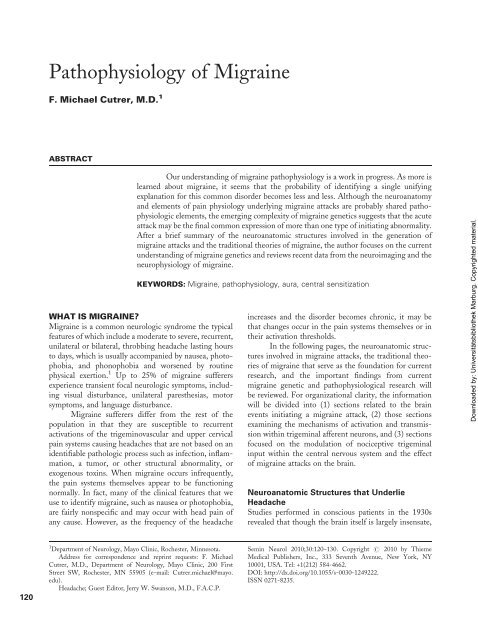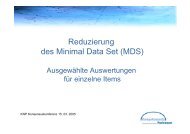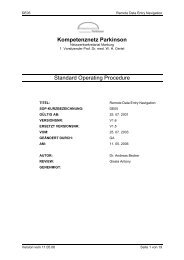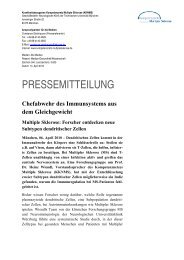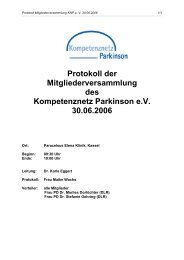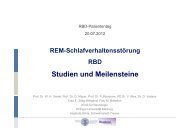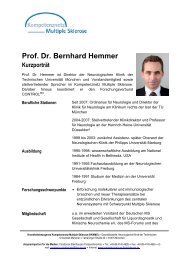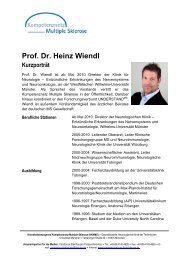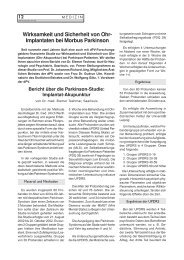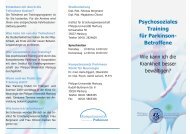Pathophysiology of Migraine - Kompetenznetz Parkinson
Pathophysiology of Migraine - Kompetenznetz Parkinson
Pathophysiology of Migraine - Kompetenznetz Parkinson
Create successful ePaper yourself
Turn your PDF publications into a flip-book with our unique Google optimized e-Paper software.
<strong>Pathophysiology</strong> <strong>of</strong> <strong>Migraine</strong><br />
F. Michael Cutrer, M.D. 1<br />
ABSTRACT<br />
Our understanding <strong>of</strong> migraine pathophysiology is a work in progress. As more is<br />
learned about migraine, it seems that the probability <strong>of</strong> identifying a single unifying<br />
explanation for this common disorder becomes less and less. Although the neuroanatomy<br />
and elements <strong>of</strong> pain physiology underlying migraine attacks are probably shared pathophysiologic<br />
elements, the emerging complexity <strong>of</strong> migraine genetics suggests that the acute<br />
attack may be the final common expression <strong>of</strong> more than one type <strong>of</strong> initiating abnormality.<br />
After a brief summary <strong>of</strong> the neuroanatomic structures involved in the generation <strong>of</strong><br />
migraine attacks and the traditional theories <strong>of</strong> migraine, the author focuses on the current<br />
understanding <strong>of</strong> migraine genetics and reviews recent data from the neuroimaging and the<br />
neurophysiology <strong>of</strong> migraine.<br />
KEYWORDS: <strong>Migraine</strong>, pathophysiology, aura, central sensitization<br />
WHAT IS MIGRAINE?<br />
<strong>Migraine</strong> is a common neurologic syndrome the typical<br />
features <strong>of</strong> which include a moderate to severe, recurrent,<br />
unilateral or bilateral, throbbing headache lasting hours<br />
to days, which is usually accompanied by nausea, photophobia,<br />
and phonophobia and worsened by routine<br />
physical exertion. 1 Up to 25% <strong>of</strong> migraine sufferers<br />
experience transient focal neurologic symptoms, including<br />
visual disturbance, unilateral paresthesias, motor<br />
symptoms, and language disturbance.<br />
<strong>Migraine</strong> sufferers differ from the rest <strong>of</strong> the<br />
population in that they are susceptible to recurrent<br />
activations <strong>of</strong> the trigeminovascular and upper cervical<br />
pain systems causing headaches that are not based on an<br />
identifiable pathologic process such as infection, inflammation,<br />
a tumor, or other structural abnormality, or<br />
exogenous toxins. When migraine occurs infrequently,<br />
the pain systems themselves appear to be functioning<br />
normally. In fact, many <strong>of</strong> the clinical features that we<br />
use to identify migraine, such as nausea or photophobia,<br />
are fairly nonspecific and may occur with head pain <strong>of</strong><br />
any cause. However, as the frequency <strong>of</strong> the headache<br />
increases and the disorder becomes chronic, it may be<br />
that changes occur in the pain systems themselves or in<br />
their activation thresholds.<br />
In the following pages, the neuroanatomic structures<br />
involved in migraine attacks, the traditional theories<br />
<strong>of</strong> migraine that serve as the foundation for current<br />
research, and the important findings from current<br />
migraine genetic and pathophysiological research will<br />
be reviewed. For organizational clarity, the information<br />
will be divided into (1) sections related to the brain<br />
events initiating a migraine attack, (2) those sections<br />
examining the mechanisms <strong>of</strong> activation and transmission<br />
within trigeminal afferent neurons, and (3) sections<br />
focused on the modulation <strong>of</strong> nociceptive trigeminal<br />
input within the central nervous system and the effect<br />
<strong>of</strong> migraine attacks on the brain.<br />
Neuroanatomic Structures that Underlie<br />
Headache<br />
Studies performed in conscious patients in the 1930s<br />
revealed that though the brain itself is largely insensate,<br />
Downloaded by: Universitätsbibliothek Marburg. Copyrighted material.<br />
120<br />
1 Department <strong>of</strong> Neurology, Mayo Clinic, Rochester, Minnesota.<br />
Address for correspondence and reprint requests: F. Michael<br />
Cutrer, M.D., Department <strong>of</strong> Neurology, Mayo Clinic, 200 First<br />
Street SW, Rochester, MN 55905 (e-mail: Cutrer.michael@mayo.<br />
edu).<br />
Headache; Guest Editor, Jerry W. Swanson, M.D., F.A.C.P.<br />
Semin Neurol 2010;30:120–130. Copyright # 2010 by Thieme<br />
Medical Publishers, Inc., 333 Seventh Avenue, New York, NY<br />
10001, USA. Tel: +1(212) 584-4662.<br />
DOI: http://dx.doi.org/10.1055/s-0030-1249222.<br />
ISSN 0271-8235.
the dura mater, the intracranial segments <strong>of</strong> the trigeminal,<br />
the vagus, and glossopharyngeal nerves, and the<br />
proximal portions <strong>of</strong> the large intracranial vessels including<br />
the basilar, vertebral, and carotid branches, 2,3 are<br />
highly pain-sensitive structures. Depolarization <strong>of</strong> small<br />
caliber pseudounipolar neurons projecting from the<br />
trigeminal ganglion, which invest these meningeal structures<br />
and cerebral vessels, 4 results in activation <strong>of</strong><br />
second-order neurons within the brainstem areas <strong>of</strong> the<br />
medullary trigeminal nucleus caudalis (TNC) and the<br />
dorsal horn <strong>of</strong> upper cervical spinal cord segments. 5<br />
Stimulation <strong>of</strong> trigeminal nociceptive neurons results<br />
in activation patterns, organized somatotopically along<br />
the rostrocaudal axis <strong>of</strong> the brainstem 6 in a pattern<br />
consistent with the classical ‘‘onionskin’’ distribution<br />
seen in the sensory deficits experienced in patients after<br />
trigeminal tractotomy. Once activated, second-order<br />
neurons in the TNC and cervical dorsal horn are<br />
modulated by projections from the nucleus raphe magnus,<br />
periaqueductal gray, 7 rostral trigeminal nuclei, 8 and<br />
descending cortical inhibitory systems. 9 These activated<br />
second-order neurons project to other brainstem nuclei,<br />
10,11 as well as the contralateral dorsomedial and<br />
ventroposteromedial nuclei <strong>of</strong> the thalamus. 6 Trigeminal<br />
pain is also associated with activation in several cortical<br />
areas, including the insular cortex, anterior cingulate<br />
cortex, and somatosensory cortex. 12 In the primary<br />
somatosensory cortex, trigeminal painful stimulation<br />
results in a laminar configuration similar to that observed<br />
within the brainstem trigeminal nuclei with V1 more<br />
caudal, V2 more rostral, and V3 medial, abutting the<br />
area <strong>of</strong> activation observed after stimulation <strong>of</strong> the<br />
thumb. 6<br />
Traditional Theories <strong>of</strong> <strong>Migraine</strong> Pathogenesis:<br />
Brain versus Vessel<br />
Two competing theories dominated the discussion <strong>of</strong><br />
migraine pathogenesis throughout the 20th century. The<br />
vasogenic theory, which viewed migraine as a form <strong>of</strong><br />
vascular dysregulation and assumed that the aura was<br />
due to a transient vasoconstriction-induced hypoxemia,<br />
dominated the discussion until the 1980s. According to<br />
the vasogenic theory, migraine headache was caused by a<br />
rebound vasodilation that resulted in a mechanical depolarization<br />
<strong>of</strong> primary nociceptive neurons within the<br />
walls <strong>of</strong> engorged intra- and extracerebral vessels. 13 One<br />
<strong>of</strong> the mainstays <strong>of</strong> the vasogenic theory was the fact that<br />
it was consistent with the observed headache inducing<br />
effects <strong>of</strong> vasodilating drugs, such as nitroglycerin, and<br />
the therapeutic effects <strong>of</strong> ergotamines, which were<br />
known to be potent vasoconstrictors. Reports <strong>of</strong> no<br />
efficacy from the nonvasoconstrictive substance P antagonists<br />
in acute migraine also seemed to favor the vasogenic<br />
hypothesis. 14 However, recent imaging studies<br />
revealed that the headache induced by nitroglycerin<br />
PATHOPHYSIOLOGY OF MIGRAINE/CUTRER 121<br />
begins well after the resolution <strong>of</strong> vasodilation when<br />
vessels are at their normal baseline caliber. 15,16 In addition,<br />
other vasodilating substances, like vasoactive intestinal<br />
peptide, do not induce migraine headache. 17<br />
The alternative neurogenic theory viewed migraine<br />
as a disorder <strong>of</strong> the brain in which vascular<br />
changes were the result <strong>of</strong> neuronal dysfunction. Proponents<br />
<strong>of</strong> this theory pointed to the fact that multiple<br />
neurologic symptoms <strong>of</strong>ten occur during a single aura<br />
that are difficult to localize within a single neurovascular<br />
territory. Also in favor <strong>of</strong> the neurogenic theory were<br />
findings from neuroimaging studies conducted during<br />
spontaneous, classical visual auras, which indicated that<br />
the decreases in cortical blood flow observed during aura<br />
are not sufficient to cause ischemia, and that subsequent<br />
vasodilation does not take place until well after the onset<br />
<strong>of</strong> headache. 18–20 In addition, multiple nonvasoconstrictive<br />
treatments are known to be effective in migraine. 21<br />
Unfortunately, at this point in time, if viewed rigidly,<br />
neither theory alone can account for all <strong>of</strong> the clinical and<br />
treatment response characteristics <strong>of</strong> migraine.<br />
Genetic Factors<br />
There is accumulating evidence that migraine is a complex<br />
genetic disorder. The influence <strong>of</strong> inheritance in<br />
migraine has long been recognized. Over the past several<br />
years, investigators have identified three distinct single<br />
gene defects that may account for familial hemiplegic<br />
migraine (FHM), a rare autosomal dominantly inherited<br />
form <strong>of</strong> migraine. The first defect to be identified was for<br />
FHM type 1 and was found in a gene known as<br />
CACNA1A located on chromosome 19p13. CAC-<br />
NA1A codes for the a 1 -subunit <strong>of</strong> a brain specific<br />
voltage-gated P/Q-type calcium channel. 22 A second<br />
defect (linked to FHM type 2) has been identified on<br />
chromosome 1q23 in the ATP1A2 gene that encodes<br />
the a 2 -subunit <strong>of</strong> a Na þ /Kþ pump. 23 More recently, a<br />
third mutation on chromosome 2q24 has been associated<br />
with FHM type 3. This mutation occurs in the voltagegated<br />
sodium channel SCN1A. 24 At least 17 different<br />
mutations within the CACNA 1A have been linked to<br />
migraine or other related clinical syndromes. In addition<br />
to unilateral motor weakness, patients with FHM experience<br />
typical visual, sensory, and/or language auras with<br />
some attacks <strong>of</strong> FHM. Just as in the more common<br />
forms <strong>of</strong> migraine, FHM is more common in women<br />
than in men, possibly implicating hormonal shifts in<br />
migraine pathogenesis.<br />
Linkage analysis and various association studies<br />
have implicated numerous polymorphisms in the more<br />
common forms <strong>of</strong> migraine: migraine with aura (MA)<br />
and migraine without aura (MO). It is increasingly<br />
evident that the common forms <strong>of</strong> migraine are based<br />
on complex, heterogeneic genetics (Table 1). The obvious<br />
complexity <strong>of</strong> the underlying genetics will likely be<br />
Downloaded by: Universitätsbibliothek Marburg. Copyrighted material.
122 SEMINARS IN NEUROLOGY/VOLUME 30, NUMBER 2 2010<br />
Table 1 Genetic Sites Proposed to Be Important in the Common Forms <strong>of</strong> <strong>Migraine</strong><br />
Chromosome/Locus Gene/Protein <strong>Migraine</strong> Type Reference<br />
1p13.3 Glutathione S-Transferase (GST) MO<br />
1 p36 MTHF-R MA<br />
4 q24<br />
? MA & MO<br />
4 q21<br />
4q31.2 Endothelin type A (ETA-231 A/G) Not specified<br />
6 p12–21 ? MA MO<br />
6p21.3 Tumor necrosis factor a (TNFa) Not specified<br />
6p21.3 HLA-DRB1 MO<br />
6q25.1 Estrogen receptor 1 (ESR1) MA & MO<br />
6q25.1 Estrogen receptor 1 (ESR1) Not specified Females only<br />
9q34 Dopamine b-hydroxylase (DBH) Not specified<br />
11 q24 ? MA<br />
11 p15 DRD4 MO<br />
11q22–23 Progesterone receptor (PGR) MA & MO<br />
11q23 DRD2 Allele 1 TG dinucleotide non-coding MO<br />
11q23 Dopamine D2 (DRD2) NcoI MA<br />
14 q21–22 ? MO<br />
17q11.1-q12 Human serotonin transporter (SLC6A4) MA & MO<br />
17q23 Angiotensin converting enzyme (ACE) MO<br />
19p13.3/2 Insulin receptor INSR Not specified<br />
22q11.2 Catechol-O-methyltransferase (COMT) not specified<br />
X q24–28 ? MO<br />
MA, migraine with aura; MO, migraine without aura.<br />
a key factor in ongoing and future migraine pathophysiologic<br />
research.<br />
INVESTIGATIONS OF MIGRAINE<br />
PATHOPHYSIOLOGY<br />
Investigations <strong>of</strong> migraine pathophysiology can be divided<br />
into three groups based on the cascade <strong>of</strong> clinical<br />
events that occur during an acute migraine attack. These<br />
groups include (1) those investigations related to the<br />
brain events initiating a migraine attack; (2) those<br />
examining the mechanisms <strong>of</strong> activation and transmission<br />
within trigeminal afferent neurons, and (3) those<br />
focused on the modulation <strong>of</strong> and possible consequences<br />
<strong>of</strong> recurrent nociception trigeminal input within the<br />
central nervous system.<br />
Investigations <strong>of</strong> <strong>Migraine</strong> Attack Initiation<br />
The factors that render an individual susceptible to<br />
attack initiation arguably constitute the essential abnormality<br />
<strong>of</strong> migraine. Efforts to find a single mechanism to<br />
explain migraine are ongoing and putative sites have<br />
been suggested from the calcium channel to the rostral<br />
brainstem. However, thus far, no single convincing allencompassing<br />
mechanism has been identified. Over the<br />
past two decades, research focusing on migraine initiation<br />
has centered on (1) changes in cortical blood flow<br />
and in activation patterns during attacks <strong>of</strong> migraine<br />
with aura, (2) altered activation thresholds within the<br />
cerebral cortex, and (3) changes that occur in the<br />
activation pattern in brainstem nuclei in migraine attacks<br />
without aura.<br />
INVESTIGATIONS OF THE MIGRAINE AURA<br />
The aura consists <strong>of</strong> focal neurologic symptoms that<br />
herald the acute migraine attack and occurs in up to<br />
25% <strong>of</strong> migraine sufferers. The aura has figured prominently<br />
in attempts to study and ultimately explain migraine<br />
pathophysiology. The vasogenic theory assumed<br />
that the aura represents the consequence <strong>of</strong> an initial<br />
vasoconstrictive phase <strong>of</strong> the migraine attack. 13 However,<br />
in the 1940s Lashley, after plotting progression <strong>of</strong> his own<br />
visual scotomata, proposed that aura was due to an<br />
abnormality which spread over his visual cortex at a rate<br />
<strong>of</strong> 3 to 5 mm per minute. 48 This migratory pattern would<br />
have been atypical for an ischemic phenomenon. Around<br />
the same time, Leao, a neurophysiologist, described an<br />
electrophysiologically measurable phenomenon that appeared<br />
and migrated over the cortex <strong>of</strong> experimental<br />
animals at a slow rate <strong>of</strong> 3 to 4 mm per minute after<br />
mechanical or chemical perturbations. 49 Although this<br />
phenomenon consisted <strong>of</strong> an excitatory phase followed by<br />
a phase <strong>of</strong> depressed activity, it has been termed cortical<br />
spreading depression. Based on the slow rate spread <strong>of</strong><br />
both phenomena and the movement across neurovascular<br />
boundaries in both, it has been proposed that the aura <strong>of</strong><br />
migraine is caused by a human analogue to cortical<br />
25<br />
26<br />
27,28<br />
29<br />
30<br />
31<br />
32<br />
33<br />
34<br />
35<br />
36<br />
37<br />
38<br />
39<br />
40,41<br />
42<br />
43<br />
44<br />
45<br />
46<br />
47<br />
Downloaded by: Universitätsbibliothek Marburg. Copyrighted material.
spreading depression. According to this proposed scenario,<br />
the alterations in blood flow observed during<br />
migraine aura are secondary to decreased metabolic demand<br />
in abnormally functioning neurons rather than the<br />
underlying cause <strong>of</strong> symptoms <strong>of</strong> aura. This view is<br />
increasingly supported by evidence from functional imaging<br />
techniques applied during aura in humans.<br />
FUNCTIONAL NEUROIMAGING AND THE MIGRAINE AURA<br />
The development <strong>of</strong> noninvasive functional neuroimaging<br />
techniques have enabled investigators to study in real<br />
time the location and progression <strong>of</strong> physiologic changes<br />
that occur in the brain during migraine and migrainelike<br />
symptoms in human patients. Almost three decades<br />
ago, Olesen, Lauritzen, and their coworkers utilized<br />
intraarterial 133 Xe blood flow techniques to investigate<br />
whether changes in blood flow occurred during aura-like<br />
symptoms induced during carotid angiography. They<br />
found that regional cerebral blood flow (rCBF) was<br />
reduced by 17 to 35% in the posterior parietal and<br />
occipital lobes 50,51 during visual aura-like symptoms,<br />
although hypoperfusion in the frontal cortex was also<br />
observed occasionally in combination with the posterior<br />
drops in blood flow. The decreases in rCBF persisted for<br />
up to one hour after the initial drop at the onset <strong>of</strong> the<br />
aura-like symptoms. After one hour, rCBF either normalized<br />
or remained focally decreased. 52,53 The observed<br />
decreases in blood flow 50,52 were not large enough to<br />
cause ischemia and were termed ‘‘oligemia.’’ An anterior<br />
spread <strong>of</strong> oligemia 51 was reported in many subjects that<br />
did not respect neurovascular boundaries. Both small<br />
magnitude and spread beyond vascular territories <strong>of</strong> the<br />
rCBF tended to support a primarily neuronal origin for<br />
migraine aura. At first, Olesen’s findings were controversial,<br />
and proponents <strong>of</strong> the vascular hypothesis argued<br />
that both the severity and duration <strong>of</strong> aura might<br />
correlate with the magnitude and duration <strong>of</strong> blood<br />
flow alterations, 54 suggesting that observed decreases in<br />
blood flow are sufficient to cause the neurologic symptoms<br />
<strong>of</strong> migraine aura. However, there have been patients<br />
studied during aura who showed nominal or no<br />
disturbance in cerebral blood flow in several series. 51,52,55<br />
Others argued that Olesen’s finding were flawed by the<br />
artifact <strong>of</strong> Compton’s scatter 56 (to which 133 Xe techniques<br />
are vulnerable). They proposed that Compton’s<br />
scatter was responsible for both an underestimate <strong>of</strong><br />
CBF decrements and the apparent spreading quality <strong>of</strong><br />
the phenomenon.<br />
In the mid-1990s, Woods and coworkers fortuitously<br />
captured the onset <strong>of</strong> a spontaneous attack in a<br />
migraine sufferer undergoing blood flow measurements<br />
( 15 O-labeled water) as a control subject in an unrelated<br />
positron emission tomography (PET) study. Woods<br />
reported a bilateral spreading drop in blood flow that<br />
appeared in the visual association cortex (Brodman areas<br />
18 and 19) within a few minutes after the onset <strong>of</strong><br />
PATHOPHYSIOLOGY OF MIGRAINE/CUTRER 123<br />
bilateral occipital throbbing headache. The flow changes<br />
spread anteriorly across vascular and anatomic boundaries.<br />
18 The patient, whose previous attacks <strong>of</strong> migraine<br />
had occurred without aura, reported no visual symptoms<br />
other than a transient difficulty focusing on the visual<br />
target during the study. This episode has been viewed as<br />
an atypical visual aura; therefore, it is difficult to be<br />
certain that the findings in this case are exactly those that<br />
would be found during classical visual aura.<br />
At roughly the same time, functional magnetic<br />
resonance imaging (fMRI) techniques, including diffusion-weighted<br />
imaging (DWI), perfusion-weighted<br />
imaging (PWI), and the blood oxygen level dependent<br />
(BOLD) imaging were also beginning to be used to study<br />
migraine aura. The rapid acquisition times for many<br />
fMRI techniques allowed the evaluation <strong>of</strong> metabolic as<br />
well as hemodynamic parameters within a single attack.<br />
One case series reported DWI findings during five<br />
spontaneous migraine visual auras in four patients. 19<br />
DWI (based on detection <strong>of</strong> changes in net movement<br />
<strong>of</strong> water molecules across neuronal membranes that may<br />
result from an impairment <strong>of</strong> Na þ K þ ATPase activity<br />
seen in ischemia 57 or cortical spreading depression<br />
(CSD) 58,59 was performed during spontaneous migraine<br />
visual aura in humans. Spreading depression induced in<br />
animal models has been associated with waves <strong>of</strong> reduced<br />
apparent diffusion coefficient (ADC), moving at a rate <strong>of</strong><br />
3 millimeters per minute. The decreased cortical ADC<br />
areas returned to normal levels after 30 seconds. 58 In<br />
patients suffering from spontaneous, acute migraine visual<br />
auras and in postaural scans, quantitative ADC maps<br />
were symmetric and normal. 19 This implied that CSD<br />
was in some way different from the process underlying<br />
migraine aura. However, the DWI methods used in these<br />
studies may have had insufficient sensitivity to draw firm<br />
conclusions about changes within minute brain regions.<br />
Unlike DWI, perfusion-weighted imaging studies<br />
in the same series <strong>of</strong> spontaneous visual auras showed<br />
significant changes. PWI estimates three hemodynamic<br />
parameters: rCBF, relative cerebral blood volume<br />
(rCBV), and mean transit time (MTT) based on the<br />
decrements in signal intensity caused by the first pass <strong>of</strong> a<br />
bolus injection <strong>of</strong> a paramagnetic contrast agent (gadolinium)<br />
through the cranial vasculature. PWI is particularly<br />
sensitive to microvascular changes (capillary/<br />
arteriolar), and has higher spatial resolution than radionuclide-based<br />
techniques. rCBF and rCBV decreased,<br />
while MTT increased in gray matter <strong>of</strong> the occipital<br />
cortex contralateral to the affected visual hemifield. No<br />
detectable hemodynamic changes were seen in the thalamus,<br />
cortical areas, or brainstem during the aura. The<br />
changes in hemodynamic parameters appear to be specific<br />
to the aura. In a series <strong>of</strong> 14 attacks <strong>of</strong> migraine without<br />
aura studied from 1.5 to 11 hours after headache onset,<br />
changes in PWI parameters were not observed. 60 The<br />
PWI findings during spontaneous migraine aura using a<br />
Downloaded by: Universitätsbibliothek Marburg. Copyrighted material.
124 SEMINARS IN NEUROLOGY/VOLUME 30, NUMBER 2 2010<br />
technique that is not susceptible to the artifact <strong>of</strong> Compton’s<br />
scatter were consistent with the 133 Xe blood flow<br />
studies <strong>of</strong> Olesen.<br />
BOLD imaging, based on known increases in<br />
magnetic resonance imaging (MRI) signal intensity<br />
with decreases in local deoxyhemoglobin concentration,<br />
61 was also applied to migraine aura. In one series, 62<br />
BOLD imaging was used to study occipital cortex<br />
activation patterns induced by visual stimulation in<br />
migraine with and without aura. In five <strong>of</strong> 12 subjects,<br />
headache or visual changes (but not classical aura) was<br />
preceded by areas <strong>of</strong> signal suppression that followed<br />
initial activation, which spread across the occipital lobe<br />
at a slow rate (3 to 6 mm per minute). In a later series by<br />
the same group studying migraine attacks (with and<br />
without aura) triggered by visual stimuli, 75% were<br />
found to have increases in BOLD signal within the red<br />
nucleus and substantia nigra prior to changes seen in<br />
occipital cortex, implicating these structures in both<br />
migraine with and without aura. 63<br />
In another report, BOLD imaging performed<br />
during both spontaneous (n ¼ 2) and exercise-induced<br />
visual auras 64 revealed a loss <strong>of</strong> cortical activation to<br />
visual stimuli in the occipital lobe contralateral (but not<br />
ipsilateral) to the symptomatic visual field in all patients.<br />
Activation within the affected occipital lobe returned to<br />
normal with resolution <strong>of</strong> the clinical symptoms. In the<br />
inducible subject, BOLD imaging was started after<br />
exercise but before the onset <strong>of</strong> visual symptoms. It<br />
was continued for the full duration <strong>of</strong> visual symptoms<br />
and into the headache phase after resolution <strong>of</strong> visual<br />
symptoms. When the patient reported the beginning <strong>of</strong><br />
the aura, suppression <strong>of</strong> activation was observed first in<br />
area V3a and then expanded into the neighboring<br />
occipital cortex at a rate <strong>of</strong> 3.5 mm per minute to involve<br />
both primary visual and association areas. The area <strong>of</strong><br />
BOLD signal change within striate cortex corresponded<br />
to the retinotopic visual disturbance. At the end <strong>of</strong> the<br />
studied auras, perfusion defects were present in the same<br />
areas that had exhibited abnormal BOLD activation.<br />
The BOLD MRI findings shared several characteristics<br />
with those seen in CSD, suggesting that a human<br />
analogue <strong>of</strong> CSD might be the source <strong>of</strong> migraine visual<br />
aura. The fMRI similarities include (1) CSD and the<br />
migraine visual aura are both characterized by an initial<br />
hyperemic phase lasting 3 to 4.5 minutes; (2) the<br />
hyperemia in both CSD and migraine aura is followed<br />
by mild hypoperfusion lasting 1 to 2 hours; (3) the<br />
hyperemia/hypoperfusion signal spreads across the cortex<br />
at a slow rate (2 to 5 mm/min); (4) the BOLD signal<br />
complex during both aura and induced CSD in animals<br />
halt at major sulci; (5) evoked visual responses during<br />
CSD and during aura are suppressed and take 15<br />
minutes to recover; and (6) in CSD and migraine aura,<br />
the first affected area is the first to recover normal evoked<br />
responses. Other recent investigations have shown that<br />
CSD-like phenomena, such as intercellular calcium<br />
waves propagated in astrocytes, can modulate both<br />
neuronal and vessel function 65–67 and suggest a possible<br />
role for such phenomena in human migraine aura.<br />
ALTERED CORTICAL FUNCTION IN MIGRAINE WITH AURA<br />
If the migraine visual aura arises from an increased<br />
susceptibility to induction <strong>of</strong> CSD or a CSD-like<br />
phenomenon, then underlying differences in cortical<br />
reactivity or irritability should probably be detectable.<br />
There is increasing evidence suggesting that differences<br />
between the cortices <strong>of</strong> nonmigraine sufferers and patients<br />
with migraine with aura do, in fact, exist.<br />
In the 1980s, Welch and colleagues 68,69 using 31 P<br />
magnetic resonance spectroscopy (MRS) reported a<br />
decrease in the phosphocreatinine/inorganic phosphate<br />
ratio (an index <strong>of</strong> brain phosphorylation potential) during<br />
headache in migraine patients who had aura, but not<br />
in normal controls or migraine sufferers without aura.<br />
This altered ratio was present in the context <strong>of</strong> normal<br />
pH, suggesting that the altered cortical function was<br />
caused by defective aerobic metabolism rather than vasospasm<br />
with ischemia. In another series, low levels <strong>of</strong><br />
brain magnesium were present in migraine sufferers 70<br />
possibly augmenting N-methyl-D-aspartate (NMDA)<br />
receptor activity and thereby lowering the threshold for<br />
CSD. 71 Thus far, spectroscopy has not been performed<br />
during typical migraine aura. Evoked potential studies<br />
employing several different modalities have indicated<br />
that a lack <strong>of</strong> habituation is the most reproducible<br />
interictal abnormality in the sensory processing <strong>of</strong> migraine<br />
sufferers. Evidence <strong>of</strong> altered cortical excitability<br />
in migraine aura comes from transcranial magnetic<br />
stimulation-based studies. A blinded study found a<br />
significantly lowered threshold for phosphene (visual<br />
sensation in the absence <strong>of</strong> light) generation in the<br />
occipital cortices <strong>of</strong> migraine sufferers with aura<br />
(42.8%) compared with normal controls (57.3%)<br />
[p ¼ 0.0001]. 72 However, other investigators have found<br />
reduced cortical excitability in migraine sufferers. 73<br />
Some have suggested that an instability <strong>of</strong> regulation<br />
<strong>of</strong> cortical function rather than absolute gain or loss <strong>of</strong><br />
function may underlie the propensity to migraine aura. 74<br />
Although the details <strong>of</strong> the differences in cortical function<br />
in migraine sufferers are, thus far, not completely<br />
understood, the body <strong>of</strong> evidence for the existence <strong>of</strong><br />
altered cortical function is growing. It is likely that<br />
differences in cortical processing are involved in the<br />
generation <strong>of</strong> the aura.<br />
Investigations <strong>of</strong> Headache Activation<br />
and Evolution<br />
The central feature <strong>of</strong> the migraine syndrome is headache;<br />
that is, the recurrent activation <strong>of</strong> the trigeminocervical<br />
pain system. In the physiologic setting, this<br />
Downloaded by: Universitätsbibliothek Marburg. Copyrighted material.
activation occurs when peripheral terminals <strong>of</strong> nociceptive<br />
neurons are depolarized and then, in turn, transmit<br />
the depolarization to the central terminals causing a<br />
trans-synaptic activation <strong>of</strong> second-order neurons in<br />
the medulla and cervical spinal cord. For secondary<br />
headaches in which intracranial pathology can be identified<br />
(e.g., chemical irritants during subarachnoid hemorrhage<br />
or mechanical traction as seen with intracranial<br />
tumors), there is a static cause <strong>of</strong> activation and it is easy<br />
to understand how headaches persist for hours or days.<br />
However, in migraine no ongoing cause <strong>of</strong> activation has<br />
been identified.<br />
Thus far, a single mechanism <strong>of</strong> trigeminal activation<br />
common to all migraine sufferers has not been<br />
identified. Although direct activation <strong>of</strong> the trigeminal<br />
system by dysfunction within central areas <strong>of</strong> pain<br />
processing cannot be excluded, there is more direct<br />
evidence that activation <strong>of</strong> peripheral nociceptors may<br />
occur during acute migraine attacks, at least in some<br />
individuals. For example, sumatriptan (the prototype <strong>of</strong><br />
the highly effective ‘‘triptan’’ class <strong>of</strong> migraine abortive<br />
agents) does not avidly cross the blood–brain barrier<br />
suggesting that it acts at peripheral sites. Furthermore,<br />
during acute migraine attacks, levels <strong>of</strong> calcitonin-generelated<br />
peptide (CGRP) which is known to be released<br />
from the peripheral terminals <strong>of</strong> activated peripheral<br />
nociceptive c-fibers, rise in external jugular blood. 75<br />
ACTIVATION DURING ATTACKS OF MIGRAINE WITH AURA<br />
In migraine sufferers who experience the aura, there is<br />
increasing evidence to suggest that the cortical events<br />
responsible for the aura symptoms may also be capable <strong>of</strong><br />
activating trigeminal nociceptors. Bolay and coworkers 76<br />
have reported experimental data from animal models<br />
that demonstrate that induced spreading depression can<br />
cause vasodilation in meningeal vessels by a reflex dependent<br />
on intact trigeminal and parasympathetic neurons.<br />
These findings link events intrinsic to the cerebral<br />
cortex to changes within pain-sensitive meningeal vascular<br />
structures. This link further implicates CSD as a<br />
potentially important pain generating mechanism in<br />
migraine with aura. In addition, induced CSD within<br />
the brains <strong>of</strong> experimental animals was shown in the<br />
mid-1990s to result in the expression <strong>of</strong> the immediate<br />
early gene c-fos, a marker for activation, within the nuclei<br />
<strong>of</strong> second order neurons in the trigeminal nucleus<br />
caudalis. 77 Experimentally induced CSD is associated<br />
with the release <strong>of</strong> factors (H þ ions, K þ ions, NO, and<br />
arachidonic acid metabolites), 78–80 which when present<br />
in sufficient concentrations are capable <strong>of</strong> activating<br />
perivascular nociceptive neurons.<br />
One might ask, how do such factors cross the<br />
boundaries <strong>of</strong> normal brain compartments to gain access<br />
to the trigeminal fibers? One possibility is the activation<br />
<strong>of</strong> matrix metalloproteinases (MMP). Preliminary data 81<br />
indicate that levels <strong>of</strong> MMP9 increase as early as<br />
PATHOPHYSIOLOGY OF MIGRAINE/CUTRER 125<br />
15 minutes after a single CSD within ipsilateral cortex,<br />
which is separated from the site <strong>of</strong> CSD initiation<br />
enough to make activation due to the initiating stimulus<br />
unlikely. The increases are quite large by 3 to 6 hours and<br />
persist for 48 hours. Activation <strong>of</strong> MMP activity results<br />
in decreases in laminin and other markers <strong>of</strong> intact<br />
compartmental barriers. The findings suggest the possibility<br />
that CSD may initiate activation <strong>of</strong> trigeminal<br />
nociception.<br />
A recent study in which two <strong>of</strong> the known<br />
mutations for FHM1 were ‘‘knocked in’’ to genetically<br />
modified mice reveals a strong correlation between the<br />
clinical manifestations <strong>of</strong> the mutation and the characteristics<br />
<strong>of</strong> induced CSD. 82 One <strong>of</strong> the groups <strong>of</strong><br />
experimental mice had the R192Q mutation, which is<br />
associated with a milder form <strong>of</strong> FHM1 in humans. The<br />
other group had the S218L, a severe, sometimes lethal<br />
form <strong>of</strong> the FHM1 mutation in humans. When compared<br />
with the wild-type mice (those without any<br />
inserted mutation) both experimental groups <strong>of</strong> mice<br />
exhibited prolonged hemiparesis analogous to that seen<br />
in human FHM after induced CSD. In addition, the<br />
mice with the FHM1 mutations showed increased<br />
propagation speed for CSD, increased CSD frequency,<br />
and enhanced corticostriatal propagation <strong>of</strong> induced<br />
CSDs. In the experiment groups, susceptibility to<br />
CSD was modulated by allele dosage (homozygotes<br />
had more susceptibility than heterozygotes), mutation<br />
type (S219L mutants had more susceptibility than those<br />
with R192Q), and gender (as in human FHM, females<br />
were more susceptible to CSD induction than males).<br />
The findings are consistent with a strong correlation<br />
between CSD and FHM1.<br />
Activation in <strong>Migraine</strong> without Aura<br />
The mechanisms by which trigeminal and cervical nociceptive<br />
neurons are activated during migraine without<br />
aura are not well understood. The possibility that a<br />
CSD-like phenomenon may occur in noneloquent areas<br />
<strong>of</strong> cortex during migraine without aura cannot at this<br />
point be excluded; however, evidence from PWI does<br />
not support this view. 60 There may be one or (perhaps,<br />
more likely) several mechanisms <strong>of</strong> activation in migraine<br />
without aura that remain to be detected and<br />
elucidated.<br />
BRAINSTEM ACTIVATION DURING MIGRAINE WITHOUT<br />
AURA<br />
One possible mechanism <strong>of</strong> activation during migraine<br />
without aura was suggested in the mid-1990s by a<br />
positron emission tomography- (PET-) based study<br />
that measured blood flow changes in the brains <strong>of</strong> nine<br />
patients during spontaneous attacks <strong>of</strong> migraine without<br />
aura. 12 Increases in rCBF <strong>of</strong> 11% were measured in the<br />
medial brainstem contralateral to the headache. Effective<br />
Downloaded by: Universitätsbibliothek Marburg. Copyrighted material.
126 SEMINARS IN NEUROLOGY/VOLUME 30, NUMBER 2 2010<br />
treatment <strong>of</strong> the headache with subcutaneous sumatriptan<br />
did not reduce the midbrain CBF change, although it<br />
did reverse increases in flow observed in other cortical<br />
sites (insula and anterior cingulate gyrus). Based on these<br />
findings, it has been proposed that migraine attacks are<br />
initiated by a brainstem generator either through direct<br />
abnormal activation or through a failure <strong>of</strong> inhibition.<br />
Similar findings <strong>of</strong> pontine and midbrain activation<br />
during migraine attacks have been reported in two subsequent<br />
studies. 20,83 Brainstem activations were not observed<br />
during a headache-free interval nor were they<br />
observed in another study in which pain in the forehead<br />
was elicited by subcutaneous capsaicin injection. 84 It is<br />
unclear whether or not a generator in rostral brainstem is<br />
responsible for acute migraine attacks or whether these<br />
findings reflect brainstem modulation <strong>of</strong> pain. Nevertheless,<br />
these findings suggest that in some individuals or<br />
in some attacks, the head pain may be driven by derangements<br />
in central areas <strong>of</strong> pain processing without recourse<br />
to peripheral nociceptive activation.<br />
Modulation <strong>of</strong> the Nociceptive Input: Peripheral<br />
and Central Sensitization<br />
Thus far, the aura is the only well-characterized part <strong>of</strong> a<br />
migraine attack that precedes the headache. Although<br />
the longer prodromal phase is well described, it is widely<br />
variable in its duration and clinical features, making it<br />
difficult to study. When aura occurs, it generally persists<br />
for an hour or less and usually resolves before the headache<br />
is fully developed. If the initial activation <strong>of</strong> the<br />
trigeminal system may be transient and relatively brief<br />
(as may occur during the aura), then how does the<br />
headache persist and intensify long after the inciting<br />
activation has passed? Investigations <strong>of</strong> somatic pain<br />
suggest that two processes may be important: (1) peripheral<br />
sensitization <strong>of</strong> the primary afferent neuron, and<br />
(2) central sensitization <strong>of</strong> higher-order neurons within<br />
the brain and spinal cord.<br />
PERIPHERAL SENSITIZATION<br />
In experimental terms, peripheral sensitization develops<br />
when there is increased excitability <strong>of</strong> primary<br />
afferent neurons to mechanical stimulation after exposure<br />
to chemical/inflammatory irritation. The process<br />
may cause spontaneous firing <strong>of</strong> irritable primary afferent<br />
neurons as well. The result is that second-order<br />
neurons are bombarded with an abnormal number <strong>of</strong><br />
impulses from the primary afferent fibers. In animal<br />
studies, Strassman and colleagues 85 recorded activity<br />
from primary afferent neurons in the trigeminal ganglion<br />
during mechanical stimulation <strong>of</strong> dural venous<br />
sinuses. Chemical stimulation <strong>of</strong> the dural receptive<br />
fields by inflammatory mediators not only directly<br />
excited axons, but also enhanced their mechanical<br />
sensitivity. After chemical stimulation, the primary<br />
afferent neurons became strongly activated by mechanical<br />
stimuli that were innocuous previously. These<br />
findings suggest that chemosensitivity and sensitization<br />
within meningeal primary afferent fibers may contribute<br />
to the hypersensitivity <strong>of</strong> migraine sufferers to small<br />
changes in intracranial pressure and to the throbbing<br />
quality <strong>of</strong> a migraine headache. It is known that, upon<br />
activation, trigeminal nociceptive fibers release proinflammatory<br />
vasoactive neuropeptides from their peripheral<br />
terminals in animal models (SP, NKA, and<br />
CGRP) 86 and during acute migraine in humans<br />
(CGRP). 75 The resulting vasodilation, mast cell activation,<br />
and membrane disruption may contribute to the<br />
peripheral sensitization <strong>of</strong> the trigeminal primary afferent<br />
neurons. 87<br />
CENTRAL SENSITIZATION<br />
Upon receiving increased input from sensitized primary<br />
afferent neurons, there is evidence that second-order<br />
neurons within TNC and the dorsal horn become<br />
sensitized and begin to respond to mild stimuli that<br />
did not previously activate them. 88 Experimental studies<br />
by Burstein and coworkers 88 have shown that chemical<br />
irritants applied to the meninges lower the electrophysiologic<br />
threshold <strong>of</strong> second-order neurons to previously<br />
subthreshold low-intensity mechanical and thermal<br />
stimuli. That this electrophysiologic change correlates<br />
with pain is borne out by the fact that noxious chemical<br />
stimulation <strong>of</strong> the dura lowers the threshold for generation<br />
<strong>of</strong> cardiovascular responses (blood pressure elevation)<br />
by previously innocuous skin stimulation. 89 As<br />
central neurons receive convergent input from both<br />
intracranial meningeal/vascular structures and cutaneous<br />
structures, 88 changes in extracranial sensation (facial<br />
skin) would be expected if central sensitization occurs<br />
in migraine. The occurrence <strong>of</strong> central sensitization in<br />
humans during migraine was confirmed by a study in<br />
which 42 patients underwent repeated measurement <strong>of</strong><br />
mechanical and thermal pain thresholds in periorbital<br />
and forearm skin during and in between attacks. 90<br />
Seventy-nine percent <strong>of</strong> subjects exhibited cutaneous<br />
allodynia during the acute migraine attack. In a single<br />
well-studied case <strong>of</strong> migraine with aura, the development<br />
<strong>of</strong> allodynia occurred sequentially throughout the<br />
course <strong>of</strong> the attack. Allodynia was not present when<br />
testing was performed in the absence <strong>of</strong> a migraine attack<br />
but developed on ipsilateral face within one hour after<br />
the onset <strong>of</strong> headache and expanded to also involve<br />
contralateral head and ipsilateral arm at 2 hours after<br />
headache onset. Allodynia intensified further within a<br />
similar distribution at 4 hours. 91 Taken together, these<br />
findings suggest that hypersensitivity within secondorder<br />
neurons may, in turn, result in sensitization at<br />
third- and higher-order levels. However, one recent<br />
study reported thermal pain thresholds dropped prior<br />
to the onset <strong>of</strong> migraine. 92<br />
Downloaded by: Universitätsbibliothek Marburg. Copyrighted material.
Another study indicates that the b-1-adrenergic<br />
antagonists, propranolol and atenolol, inhibit firing <strong>of</strong><br />
third-order thalamocortical neurons to dural (sagittal<br />
sinus) stimulation and L-glutamate injection suggesting<br />
that these drugs, which are <strong>of</strong> known efficacy in migraine,<br />
might act to negatively modulate and perhaps<br />
suppress the tendency toward central sensitization in<br />
higher-order neurons. 93 Other interesting data indicate<br />
that in recurrent migraine there is deposition <strong>of</strong> nonheme<br />
iron within areas <strong>of</strong> periaqueductal gray that<br />
directly correlates with the total duration <strong>of</strong> illness. 94 It<br />
has been suggested that these changes result from<br />
repeated attacks. These findings have recently been<br />
confirmed in migraine sufferers under the age <strong>of</strong> 50 in<br />
a large population-based cohort (migraine cases n ¼ 178<br />
and controls n ¼ 75). 95 When stratified by age, subjects<br />
under the age <strong>of</strong> 50 (n ¼ 50) had lower T2 values on MR<br />
imaging suggesting iron deposition in the putamen<br />
(p ¼ 0.02), globus pallidus (p ¼ 0.03), and red nucleus<br />
(p ¼ 0.03). When subjects over the age <strong>of</strong> 50 were<br />
included, no differences were seen. However, whether<br />
these findings <strong>of</strong> apparent iron accumulation represent<br />
injury in response to repeated activation <strong>of</strong> the pain<br />
system and its modulation in periaqueductal gray or<br />
alternatively represent the cause <strong>of</strong> dysfunctional control<br />
within the trigeminovascular nociceptive system is unclear.<br />
In a similar vein, a subsequent PET-based study 96<br />
has suggested altered brainstem function in patients with<br />
chronic migraine.<br />
White Matter Changes in <strong>Migraine</strong> Patients<br />
Over the past few years, there has been increased interest<br />
in an apparent increased occurrence <strong>of</strong> small foci T2<br />
signal on MRI (presumed infarctions) and in white<br />
matter lesions in migraine patients compared with the<br />
nonmigrainous population. In a large study <strong>of</strong> randomly<br />
selected, age- and gender-matched patients with migraine<br />
with aura (n ¼ 161), migraine without aura<br />
(n ¼ 134), and controls (n ¼ 140), the investigators<br />
found no significant difference between patients with<br />
migraine and controls in overall infarct prevalence (8.1%<br />
vs. 5.0%). However, in the cerebellar region <strong>of</strong> the<br />
posterior circulation territory, they found that patients<br />
with migraine had a higher prevalence <strong>of</strong> infarct than<br />
controls (5.4% vs. 0.7%; P =.02). The adjusted odds<br />
ratios (ORs) for posterior infarction varied based on<br />
migraine subtype and attack frequency. Patients with<br />
migraine with aura and those with greater that one<br />
attack per month had the highest risk <strong>of</strong> infarct compared<br />
with controls. Among women, the risk <strong>of</strong> deep<br />
white matter lesions (DWML) was increased in patients<br />
with migraine compared with controls (OR 2.1; 95%<br />
confidence interval [CI] 1.0–4.1); this risk increased<br />
with attack frequency (highest in those with one attack<br />
per month: OR 2.6; 95% CI 1.2–5.7), but was similar in<br />
patients with migraine with or without aura. In men,<br />
controls and patients with migraine did not differ in the<br />
prevalence <strong>of</strong> DWMLs. None <strong>of</strong> the cerebellar lesions<br />
correlated with clinical symptoms. 97,98 The cause <strong>of</strong> the<br />
lesions remains unclear, although ischemia resulting<br />
from the recurrent periods <strong>of</strong> hypoperfusion during<br />
aura has been suggested. However, one report suggests<br />
that these lesions may be transient, 99 which would be<br />
unexpected were ischemia to be their underlying cause.<br />
Another proposed explanation is that the subclinical<br />
lesions observed in the posterior circulation <strong>of</strong><br />
migraine sufferers might result from recurrent microemboli<br />
that gain access to cerebral circulation through a<br />
patent foramen ovale (PFO). An increased prevalence <strong>of</strong><br />
PFO in migraine with aura sufferers has been reported<br />
by several investigators, 100 and several uncontrolled trials<br />
have suggested that PFO closure resulted in a decrease in<br />
migraine attack frequency. 101,102 However, the MIST<br />
study, the first controlled trial, did not meet its primary<br />
efficacy endpoint. 103 Other controlled trials are currently<br />
underway. A recent study in migraine patients which<br />
used transcranial Doppler techniques to detect gaseous<br />
microemboli arising from right to left shunts due to PFO<br />
concluded that the presence <strong>of</strong> right-to-left shunt does<br />
not increase white matter lesion load in patients who<br />
have migraine with aura. 104<br />
CONCLUSIONS<br />
The past two decades have seen a significant increase in<br />
our understanding <strong>of</strong> several important aspects <strong>of</strong> migraine<br />
pathophysiology. However, attempts to identify a<br />
single unifying theory that encompasses and accounts for<br />
all that we know about migraine continue to be unsuccessful.<br />
The increasing evidence <strong>of</strong> genetic heterogeneity<br />
which underpins migraine, combined with the wide<br />
clinical variation seen in the disorder argues for a<br />
syndromic approach to migraine. A syndromic approach<br />
recognizes an acute migraine attack as a clinical ‘‘final<br />
common pathway’’ reflecting a recurrent maladaptive<br />
activation <strong>of</strong> the trigeminocervical pain apparatus which<br />
may arise from more than one initiating process. Research<br />
based on a syndromic view <strong>of</strong> migraine may<br />
ultimately aid in the identification <strong>of</strong> clinically and<br />
perhaps genetically definable subgroups that may allow<br />
for more effective, individualized therapy for this very<br />
common, disabling disorder.<br />
REFERENCES<br />
PATHOPHYSIOLOGY OF MIGRAINE/CUTRER 127<br />
1. Headache Classification Subcommittee <strong>of</strong> the International<br />
Headache Society. The international classification <strong>of</strong> headache<br />
disorders, 2nd edition. Cephalalgia 2004;24(Suppl 1):<br />
9–160<br />
2. Penfield W. A contribution to the mechanism <strong>of</strong> intracranial<br />
pain. Association for Research in Nervous and Mental<br />
Disease Proceedings (1934) 1935;15:399–416<br />
Downloaded by: Universitätsbibliothek Marburg. Copyrighted material.
128 SEMINARS IN NEUROLOGY/VOLUME 30, NUMBER 2 2010<br />
3. Ray BS, Wolff HG. Experimental studies on headache.<br />
Pain-sensitive structures <strong>of</strong> the head and their significance in<br />
headache. Arch Surg 1940;41:813–856<br />
4. Mayberg MR, Zervas NT, Moskowitz MA. Trigeminal<br />
projections to supratentorial pial and dural blood vessels in<br />
cats demonstrated by horseradish peroxidase histochemistry.<br />
J Comp Neurol 1984;223(1):46–56<br />
5. Nozaki K, Boccalini P, Moskowitz MA. Expression <strong>of</strong><br />
c-fos-like immunoreactivity in brainstem after meningeal<br />
irritation by blood in the subarachnoid space. Neuroscience<br />
1992;49(3):669–680<br />
6. DaSilva AFM, Becerra L, Makris N, et al. Somatotopic<br />
activation in the human trigeminal pain pathway. J Neurosci<br />
2002;22(18):8183–8192<br />
7. Sessle BJ, Hu JW, Dubner R, Lucier GE. Functional<br />
properties <strong>of</strong> neurons in cat trigeminal subnucleus caudalis<br />
(medullary dorsal horn). II. Modulation <strong>of</strong> responses to<br />
noxious and nonnoxious stimuli by periaqueductal gray,<br />
nucleus raphe magnus, cerebral cortex, and afferent<br />
influences, and effect <strong>of</strong> nalaxone. J Neurophysiol 1981;45:<br />
193–207<br />
8. Kruger L, Young RF. Specialized features <strong>of</strong> the trigeminal<br />
nerve and its central connections. In: Samii M, Janetta PJ,<br />
eds. The Cranial Nerves. Berlin: Springer-Verlag; 1981:<br />
273–301<br />
9. Wise SP, Jones EG. Cells <strong>of</strong> origin and terminal<br />
distribution <strong>of</strong> descending projections <strong>of</strong> the rat somatic<br />
sensory cortex. J Comp Neurol 1977;175(2):129–157<br />
10. Jacquin MF, Chiaia NL, Haring JH, Rhoades RW.<br />
Intersubnuclear connections within the rat trigeminal<br />
brainstem complex. Somatosens Mot Res 1990;7(4):399–<br />
420<br />
11. Renehan WE, Jacquin MF, Mooney RD, Rhoades RW.<br />
Structure-function relationships in rat medullary and<br />
cervical dorsal horns. II. Medullary dorsal horn cells.<br />
J Neurophysiol 1986;55(6):1187–1201<br />
12. Weiller C, May A, Limmroth V, et al. Brain stem activation<br />
in spontaneous human migraine attacks. Nat Med 1995;<br />
1(7):658–660<br />
13. Wolff HG. Headache and Other Head Pain. 2nd ed. New<br />
York: Oxford University Press; 1963<br />
14. Diener HC, RPR100893 Study Group. RPR100893, a<br />
substance-P antagonist, is not effective in the treatment <strong>of</strong><br />
migraine attacks. Cephalalgia 2003;23(3):183–185<br />
15. Kruuse C, Thomsen LL, Birk S, Olesen J. <strong>Migraine</strong> can be<br />
induced by sildenafil without changes in middle cerebral<br />
artery diameter. Brain 2003;126(Pt 1):241–247<br />
16. Schoonman GG, van der Grond J, Kortmann C, van der<br />
Geest RJ, Terwindt GM, Ferrari MD. <strong>Migraine</strong> headache is<br />
not associated with cerebral or meningeal vasodilatation—a<br />
3T magnetic resonance angiography study. Brain 2008;131<br />
(Pt 8):2192–2200<br />
17. Rahmann A, Wienecke T, Hansen JM, Fahrenkrug J,<br />
Olesen J, Ashina M. Vasoactive intestinal peptide causes<br />
marked cephalic vasodilation, but does not induce migraine.<br />
Cephalalgia 2008;28(3):226–236<br />
18. Woods RP, Iacoboni M, Mazziotta JC. Brief report:<br />
bilateral spreading cerebral hypoperfusion during spontaneous<br />
migraine headache. N Engl J Med 1994;331(25):<br />
1689–1692<br />
19. Cutrer FM, Sorensen AG, Weissk<strong>of</strong>f RM, et al. Perfusionweighted<br />
imaging defects during spontaneous migrainous<br />
aura. Ann Neurol 1998;43(1):25–31<br />
20. Denuelle M, Fabre N, Payoux P, Chollet F, Geraud G.<br />
Posterior cerebral hypoperfusion in migraine without aura.<br />
Cephalalgia 2008;28(8):856–862<br />
21. Cutrer FM, Charles A. The neurogenic basis <strong>of</strong> migraine.<br />
Headache 2008;48(9):1411–1414<br />
22. Oph<strong>of</strong>f RA, Terwindt GM, Vergouwe MN, et al. Familial<br />
hemiplegic migraine and episodic ataxia type-2 are caused by<br />
mutations in the Ca2 þ channel gene CACNL1A4. Cell<br />
1996;87(3):543–552<br />
23. De Fusco M, Marconi R, Silvestri L, et al. Haploinsufficiency<br />
<strong>of</strong> ATP1A2 encoding the Naþ/Kþpump alpha2<br />
subunit associated with familial hemiplegic migraine type 2.<br />
Nat Genet 2003;33(2):192–196<br />
24. Dichgans M, Freilinger T, Eckstein G, et al. Mutation in<br />
the neuronal voltage-gated sodium channel SCN1A in<br />
familial hemiplegic migraine. Lancet 2005;366(9483):<br />
371–377<br />
25. Kusumi M, Ishizaki K, Kowa H, et al. Glutathione S-<br />
transferase polymorphisms: susceptibility to migraine without<br />
aura. Eur Neurol 2003;49(4):218–222<br />
26. Kara I, Sazci A, Ergul E, Kaya G, Kilic G. Association <strong>of</strong><br />
the C677T and A1298C polymorphisms in the 5,10<br />
methylenetetrahydr<strong>of</strong>olate reductase gene in patients with<br />
migraine risk. Brain Res Mol Brain Res 2003;17;111<br />
(1–2):84–90<br />
27. Wessman M, Kallela M, Kaunisto MA, et al. A susceptibility<br />
locus for migraine with aura, on chromosome 4q24.<br />
Am J Hum Genet 2002;70(3):652–662<br />
28. Björnsson A, Gudmundsson G, Gudfinnsson E, et al.<br />
Localization <strong>of</strong> a gene for migraine without aura to<br />
chromosome 4q21. Am J Hum Genet 2003;73(5):986–993<br />
29. Tzourio C, El Amrani M, Poirier O, Nicaud V, Bousser<br />
MG, Alpérovitch A. Association between migraine and<br />
endothelin type A receptor (ETA -231 A/G) gene polymorphism.<br />
Neurology 2001;56(10):1273–1277<br />
30. Carlsson A, Forsgren L, Nylander P-O, et al. Identification<br />
<strong>of</strong> a susceptibility locus for migraine with and without aura<br />
on 6p12.2-p21.1. Neurology 2002;59(11):1804–1807<br />
31. Rainero I, Grimaldi LM, Salani G, et al. Association<br />
between the tumor necrosis factor-alpha -308 G/A gene<br />
polymorphism and migraine. Neurology 2004;62(1):141–<br />
143<br />
32. Rainero I, Fasano E, Rubino E, et al. Association between<br />
migraine and HLA-DRB1 gene polymorphisms. J Headache<br />
Pain 2005;6(4):185–187<br />
33. Colson NJ, Lea RA, Quinlan S, MacMillan J, Griffiths LR.<br />
The estrogen receptor 1 G594A polymorphism is associated<br />
with migraine susceptibility in two independent case/control<br />
groups. Neurogenetics 2004;5(2):129–133<br />
34. Oterino A, Pascual J, Ruiz de Alegría C, et al. Association<br />
<strong>of</strong> migraine and ESR1 G325C polymorphism. Neuroreport<br />
2006;17(1):61–64<br />
35. Lea RA, Dohy A, Jordan K, Quinlan S, Brimage PJ,<br />
Griffiths LR. Evidence for allelic association <strong>of</strong> the<br />
dopamine beta-hydroxylase gene (DBH) with susceptibility<br />
to typical migraine. Neurogenetics 2000;3(1):35–40<br />
36. Cader ZM, Noble-Topham S, Dyment DA, et al.<br />
Significant linkage to migraine with aura on chromosome<br />
11q24. Hum Mol Genet 2003;12(19):2511–2517<br />
37. Mochi M, Cevoli S, Cortelli P, et al. A genetic association<br />
study <strong>of</strong> migraine with dopamine receptor 4, dopamine<br />
transporter and dopamine-beta-hydroxylase genes. Neurol Sci<br />
2003;23(6):301–305<br />
Downloaded by: Universitätsbibliothek Marburg. Copyrighted material.
PATHOPHYSIOLOGY OF MIGRAINE/CUTRER 129<br />
38. Colson NJ, Lea RA, Quinlan S, MacMillan J, Griffiths LR.<br />
Investigation <strong>of</strong> hormone receptor genes in migraine.<br />
Neurogenetics 2005;6(1):17–23<br />
39. Del Zompo M, Cherchi A, Palmas MA, et al. Association<br />
between dopamine receptor genes and migraine without<br />
aura in a Sardinian sample. Neurology 1998;51(3):<br />
781–786<br />
40. Peroutka SJ, Price SC, Wilhoit TL, Jones KW. Comorbid<br />
migraine with aura, anxiety, and depression is associated<br />
with dopamine D2 receptor (DRD2) NcoI alleles. Mol Med<br />
1998;4(1):14–21<br />
41. Peroutka SJ, Wilhoit T, Jones K. Clinical susceptibility to<br />
migraine with aura is modified by dopamine D2 receptor<br />
(DRD2) NcoI alleles. Neurology 1997;49(1):201–206<br />
42. Soragna D, Vettori A, Carraro G, et al. A locus for migraine<br />
without aura maps on chromosome 14q21.2-q22.3. Am J<br />
Hum Genet 2003;72(1):161–167<br />
43. Ogilvie AD, Russell MB, Dhall P, et al. Altered allelic<br />
distributions <strong>of</strong> the serotonin transporter gene in migraine<br />
without aura and migraine with aura. Cephalalgia 1998;<br />
18(1):23–26<br />
44. Paterna S, Di Pasquale P, D’Angelo A, et al. Angiotensinconverting<br />
enzyme gene deletion polymorphism determines<br />
an increase in frequency <strong>of</strong> migraine attacks in patients<br />
suffering from migraine without aura. Eur Neurol 2000;<br />
43(3):133–136<br />
45. McCarthy LC, Hosford DA, Riley JH, et al. Singlenucleotide<br />
polymorphism alleles in the insulin receptor gene<br />
are associated with typical migraine. Genomics 2001;78(3):<br />
135–149<br />
46. Emin Erdal M, Herken H, Yilmaz M, Bayazit YA.<br />
Significance <strong>of</strong> the catechol-O-methyltransferase gene polymorphism<br />
in migraine. Brain Res Mol Brain Res 2001;94<br />
(1-2):193–196<br />
47. Nyholt DR, Dawkins JL, Brimage PJ, Goadsby PJ,<br />
Nicholson GA, Griffiths LR. Evidence for an X-linked<br />
genetic component in familial typical migraine. Hum Mol<br />
Genet 1998;7(3):459–463<br />
48. Lashley KS. Patterns <strong>of</strong> cerebral integration indicated by the<br />
scotomas <strong>of</strong> migraine. Archives <strong>of</strong> Neurology and Psychiatry<br />
1941;46:331–339<br />
49. Leao AAP. Spreading depression <strong>of</strong> activity in the cerebral<br />
cortex. J Neurophysiol 1944;7:359–390<br />
50. Olesen J, Larsen B, Lauritzen M. Focal hyperemia followed<br />
by spreading oligemia and impaired activation <strong>of</strong> rCBF in<br />
classic migraine. Ann Neurol 1981;9(4):344–352<br />
51. Lauritzen M, Skyhøj Olsen T, Lassen NA, Paulson OB.<br />
Changes in regional cerebral blood flow during the course <strong>of</strong><br />
classic migraine attacks. Ann Neurol 1983;13(6):633–641<br />
52. Lauritzen M, Olesen J. Regional cerebral blood flow during<br />
migraine attacks by Xenon-133 inhalation and emission<br />
tomography. Brain 1984;107(Pt 2):447–461<br />
53. Olesen J, Friberg L, Olsen TS, et al. Timing and<br />
topography <strong>of</strong> cerebral blood flow, aura, and headache<br />
during migraine attacks. Ann Neurol 1990;28(6):791–798<br />
54. Friberg L, Olsen TS, Roland PE, Lassen NA. Focal<br />
ischemia caused by instability <strong>of</strong> cerebrovascular tone during<br />
attacks <strong>of</strong> hemiplegic migraine. A regional cerebral blood<br />
flow study. Brain 1987;110:917–934<br />
55. Andersen AR, Friberg L, Olsen TS, Olesen J. Delayed<br />
hyperemia following hypoperfusion in classic migraine.<br />
Single photon emission computed tomographic demonstration.<br />
Arch Neurol 1988;45:154–159<br />
56. Skyhøj Olsen T, Friberg L, Lassen NA. Ischemia may be<br />
the primary cause <strong>of</strong> the neurologic deficits in classic<br />
migraine. Arch Neurol 1987;44(2):156–161<br />
57. Warach S, Gaa J, Siewert B, Wielopolski P, Edelman RR.<br />
Acute human stroke studied by whole brain echo planar<br />
diffusion-weighted magnetic resonance imaging. Ann Neurol<br />
1995;37(2):231–241<br />
58. Gardner-Medwin AR, van Bruggen N, Williams SR, Ahier<br />
RG. Magnetic resonance imaging <strong>of</strong> propagating waves <strong>of</strong><br />
spreading depression in the anaesthetised rat. J Cereb Blood<br />
Flow Metab 1994;14(1):7–11<br />
59. Hasegawa Y, Latour LL, Sotak C, et al. Spreading waves <strong>of</strong><br />
reduced diffusion coefficient <strong>of</strong> water in the rat brain.<br />
Neurology 1994;44(Suppl 2):A34<br />
60. Sanchez del Rio M, Bakker D, Wu O, et al. Perfusion<br />
weighted imaging during migraine: Spontaneous visual aura<br />
and headache. Cephalalgia 1999;19:701–717<br />
61. Sorensen AG, Rosen BR. Functional MRI <strong>of</strong> the brain. In:<br />
Magnetic Resonance Imaging <strong>of</strong> the Brain and Spine. 2nd<br />
Ed. Philadelphia: Lippincott-Raven Publishers; 1996<br />
62. Cao Y, Welch KM, Aurora S, Vikingstad EM. Functional<br />
MRI-BOLD <strong>of</strong> visually triggered headache in patients with<br />
migraine. Arch Neurol 1999;56(5):548–554<br />
63. Cao Y, Aurora SK, Nagesh V, Patel SC, Welch KM.<br />
Functional MRI-BOLD <strong>of</strong> brainstem structures during<br />
visually triggered migraine. Neurology 2002;59(1):72–78<br />
64. Hadjikhani N, Sanchez Del Rio M, Wu O, et al. Mechanisms<br />
<strong>of</strong> migraine aura revealed by functional MRI in human visual<br />
cortex. Proc Natl Acad Sci U S A 2001;98(8):4687–4692<br />
65. Charles A. Intercellular calcium waves in glia. Glia 1998;<br />
24(1):39–49<br />
66. Haydon PG, Carmignoto G. Astrocyte control <strong>of</strong> synaptic<br />
transmission and neurovascular coupling. Physiol Rev 2006;<br />
86(3):1009–1031<br />
67. Chuquet J, Hollender L, Nimchinsky EA. High-resolution<br />
in vivo imaging <strong>of</strong> the neurovascular unit during spreading<br />
depression. J Neurosci 2007;27(15):4036–4044<br />
68. Welch KM, Levine SR, D’Andrea G, Helpern JA. Brain<br />
pH during migraine: an in vivo phosphorus-31 magnetic<br />
resonance spectroscopy study. Cephalalgia 1988;8:273–277<br />
69. Welch KM, Levine SR, D’Andrea G, Schultz LR, Helpern<br />
JA. Preliminary observations on brain energy metabolism in<br />
migraine studied by in vivo phosphorus 31 NMR spectroscopy.<br />
Neurology 1989;39(4):538–541<br />
70. Welch KMA, Barkley GL, Ramadan NM, D’Andrea G.<br />
NMR spectroscopic and magnetoencephalographic studies<br />
in migraine with aura: support for the spreading depression<br />
hypothesis. Pathol Biol (Paris) 1992;40(4):349–354<br />
71. Van Harreveld A, Fifková E. Mechanisms involved in<br />
spreading depression. J Neurobiol 1973;4(4):375–387<br />
72. Aurora SK, Welch KM, Al-Sayed F. The threshold for<br />
phosphenes is lower in migraine. Cephalalgia 2003;23(4):<br />
258–263<br />
73. Ambrosini A, Schoenen J. Electrophysiological response<br />
patterns <strong>of</strong> primary sensory cortices in migraine. J Headache<br />
Pain 2006;7(6):377–388<br />
74. Stankewitz A, May A. Cortical excitability and migraine.<br />
Cephalalgia 2007;27(12):1454–1456<br />
75. Goadsby PJ, Edvinsson L, Ekman R. Vasoactive peptide<br />
release in the extracerebral circulation <strong>of</strong> humans during<br />
migraine headache. Ann Neurol 1990;28(2):183–187<br />
76. Bolay H, Reuter U, Dunn AK, Huang Z, Boas DA,<br />
Moskowitz MA. Intrinsic brain activity triggers trigeminal<br />
Downloaded by: Universitätsbibliothek Marburg. Copyrighted material.
130 SEMINARS IN NEUROLOGY/VOLUME 30, NUMBER 2 2010<br />
meningeal afferents in a migraine model. Nat Med<br />
2002;8(2):136–142<br />
77. Moskowitz MA, Nozaki K, Kraig RP. Neocortical spreading<br />
depression provokes the expression <strong>of</strong> c-fos protein-like<br />
immunoreactivity within trigeminal nucleus caudalis via<br />
trigeminovascular mechanisms. J Neurosci 1993;13(3):<br />
1167–1177<br />
78. Kraig RP, Nicholson C. Extracellular ionic variations during<br />
spreading depression. Neuroscience 1978;3(11):1045–1059<br />
79. Obrenovitch TP, Urenjak J, Wang M. Nitric oxide<br />
formation during cortical spreading depression is critical<br />
for rapid subsequent recovery <strong>of</strong> ionic homeostasis. J Cereb<br />
Blood Flow Metab 2002;22(6):680–688<br />
80. Lauritzen M, Hansen AJ, Kronborg D, Wieloch T. Cortical<br />
spreading depression is associated with arachidonic acid<br />
accumulation and preservation <strong>of</strong> energy charge. J Cereb<br />
Blood Flow Metab 1990;10(1):115–122<br />
81. Gursoy-Ozdemir Y, Qiu J, Matsuoka N, et al. Cortical<br />
spreading depression activates and upregulates MMP-9.<br />
J Clin Invest 2004;113(10):1447–1455<br />
82. Eikermann-Haerter K, Dileköz E, Kudo C, et al. Genetic<br />
and hormonal factors modulate spreading depression and<br />
transient hemiparesis in mouse models <strong>of</strong> familial hemiplegic<br />
migraine type 1. J Clin Invest 2009;119(1):99–109<br />
83. Afridi SK, Matharu MS, Lee L, et al. A PET study<br />
exploring the laterality <strong>of</strong> brainstem activation in migraine<br />
using glyceryl trinitrate. Brain 2005;128(Pt 4):932–939<br />
84. May A, Kaube H, Büchel C, et al. Experimental cranial pain<br />
elicited by capsaicin: a PET study. Pain 1998;74(1):61–66<br />
85. Strassman AM, Raymond SA, Burstein R. Sensitization <strong>of</strong><br />
meningeal sensory neurons and the origin <strong>of</strong> headaches.<br />
Nature 1996;384(6609):560–564<br />
86. Moskowitz MA, Buzzi MG. Neuroeffector functions <strong>of</strong><br />
sensory fibres: implications for headache mechanisms and<br />
drug actions. J Neurol 1991;238(Suppl 1):S18–S22<br />
87. Moskowitz MA, Cutrer FM. Possible importance <strong>of</strong> neurogenic<br />
inflammation within the meninges to migraine headaches.<br />
In: Fields HL, Liebeskind JC, eds. Progress in Pain<br />
Research and Management. Seattle: IASP Press; 1993: 43–49<br />
88. Burstein R, Yamamura H, Malick A, Strassman AM.<br />
Chemical stimulation <strong>of</strong> the intracranial dura induces<br />
enhanced responses to facial stimulation in brain stem<br />
trigeminal neurons. J Neurophysiol 1998;79(2):964–982<br />
89. Yamamura H, Malick A, Chamberlin NL, Burstein R.<br />
Cardiovascular and neuronal responses to head stimulation<br />
reflect central sensitization and cutaneous allodynia in a rat<br />
model <strong>of</strong> migraine. J Neurophysiol 1999;81(2):479–493<br />
90. Burstein R, Yarnitsky D, Goor-Aryeh I, Ransil BJ, Bajwa<br />
ZH. An association between migraine and cutaneous<br />
allodynia. Ann Neurol 2000;47(5):614–624<br />
91. Burstein R, Cutrer MF, Yarnitsky D. The development <strong>of</strong><br />
cutaneous allodynia during a migraine attack clinical<br />
evidence for the sequential recruitment <strong>of</strong> spinal and<br />
supraspinal nociceptive neurons in migraine. Brain 2000;<br />
123(Pt 8):1703–1709<br />
92. Sand T, Zhitniy N, Nilsen KB, Helde G, Hagen K, Stovner<br />
LJ. Thermal pain thresholds are decreased in the migraine<br />
preattack phase. Eur J Neurol 2008;15(11):1199–1205<br />
93. Shields KG, Goadsby PJ. Propranolol modulates trigeminovascular<br />
responses in thalamic ventroposteromedial<br />
nucleus: a role in migraine? Brain 2005;128(Pt 1):86–97<br />
94. Welch KM, Nagesh V, Aurora SK, Gelman N. Periaqueductal<br />
gray matter dysfunction in migraine: cause or the<br />
burden <strong>of</strong> illness? Headache 2001;41(7):629–637<br />
95. Kruit MC, Launer LJ, Overbosch J, van Buchem MA,<br />
Ferrari MD. Iron accumulation in deep brain nuclei in<br />
migraine: a population-based magnetic resonance imaging<br />
study. Cephalalgia 2009;29(3):351–359<br />
96. Aurora SK, Barrodale PM, Tipton RL, Khodavirdi A.<br />
Brainstem dysfunction in chronic migraine as evidenced by<br />
neurophysiological and positron emission tomography<br />
studies. Headache 2007;47(7):996–1003, discussion 1004–<br />
1007<br />
97. Kruit MC, van Buchem MA, H<strong>of</strong>man PA, et al. <strong>Migraine</strong><br />
as a risk factor for subclinical brain lesions. JAMA 2004;<br />
291(4):427–434<br />
98. Kruit M, van Buchem M, Launer L, Terwindt G, Ferrari<br />
M. <strong>Migraine</strong> is associated with an increased risk <strong>of</strong> deep<br />
white matter lesions, subclinical posterior circulation infarcts<br />
and brain iron accumulation: the population-based MRI<br />
CAMERA study. Cephalalgia 2009; Epub ahead <strong>of</strong> print<br />
99. Rozen TD. Vanishing cerebellar infarcts in a migraine<br />
patient. Cephalalgia 2007;27(6):557–560<br />
100. Schwedt TJ, Demaerschalk BM, Dodick DW. Patent<br />
foramen ovale and migraine: a quantitative systematic<br />
review. Cephalalgia 2008;28(5):531–540<br />
101. Anzola GP, Frisoni GB, Morandi E, Casilli F, Onorato E.<br />
Shunt-associated migraine responds favorably to atrial<br />
septal repair: a case-control study. Stroke 2006;37(2):<br />
430–434<br />
102. Reisman M, Christ<strong>of</strong>ferson RD, Jesurum J, et al. <strong>Migraine</strong><br />
headache relief after transcatheter closure <strong>of</strong> patent foramen<br />
ovale. J Am Coll Cardiol 2005;45(4):493–495<br />
103. Dowson A, Mullen MJ, Peatfield R, et al. <strong>Migraine</strong><br />
Intervention With STARFlex Technology (MIST) Trial:<br />
a prospective, multicenter, double-blind, sham-controlled<br />
trial to evaluate the effectiveness <strong>of</strong> patent foramen ovale<br />
closure with STARFlex septal repair implant to resolve<br />
refractory migraine headache. Circulation 2008;117(11):<br />
1397–1404<br />
104. Adami A, Rossato G, Cerini R, et al.on behalf <strong>of</strong> the SAM<br />
Study Group Right-to-left shunt does not increase white<br />
matter lesion load in migraine with aura patients. Neurology<br />
2008;71(2):101–107<br />
Downloaded by: Universitätsbibliothek Marburg. Copyrighted material.


